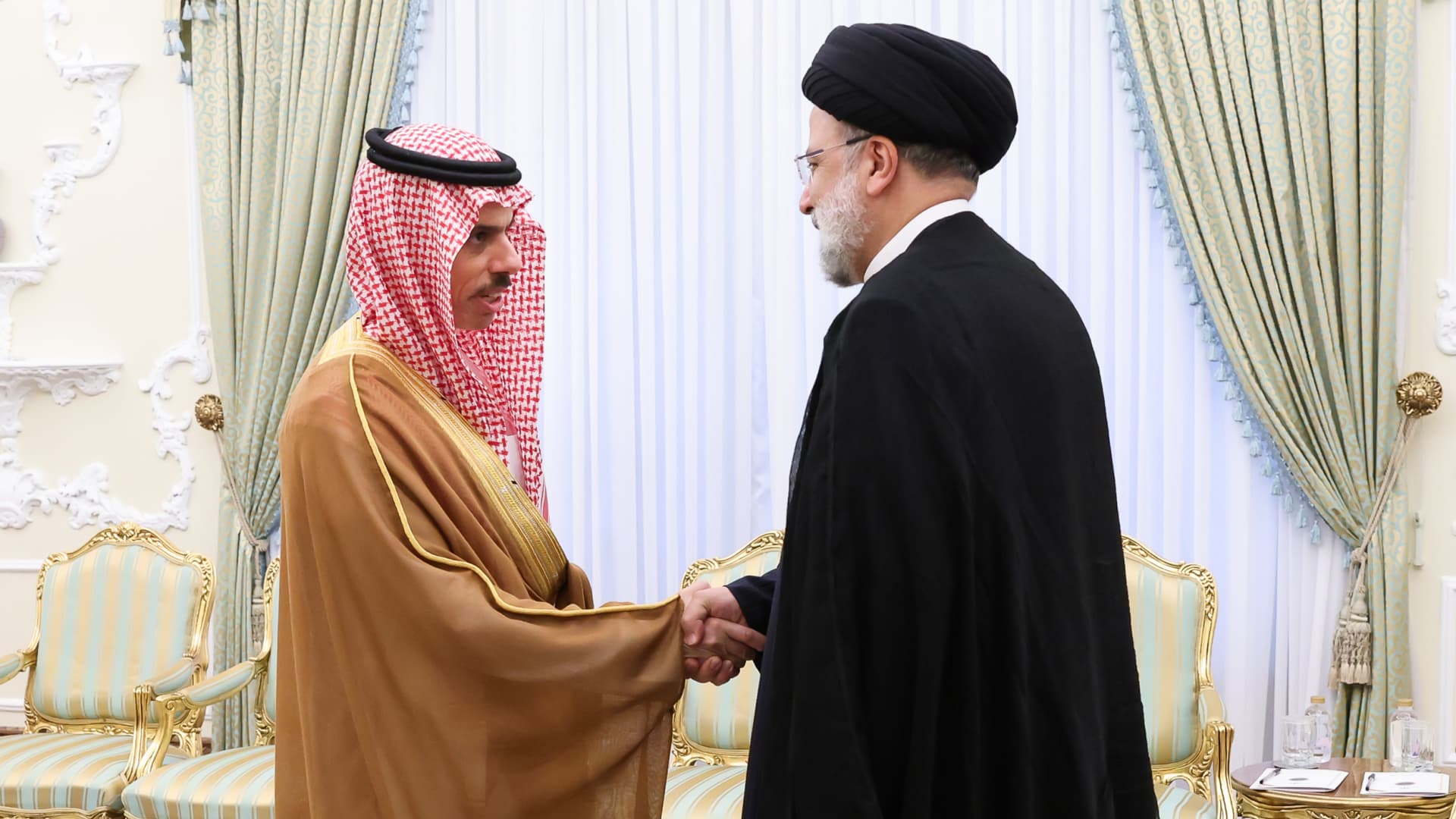Iranian President Ebrahim Raisi (right) meets with Saudi Arabian Foreign Minister Faisal bin Farhan Al-Saud in Tehran, Iran, on June 17, 2023.
Iranian Presidency | Handout | Anadolu Agency | Getty Images
Saudi Arabia’s foreign minister made a high-profile visit to Tehran over the weekend, drawing coverage and praise about the improvement in relations between Iran and Saudi Arabia, two longtime foes.
“Mutual respect, non-interference in the two countries’ internal affairs and commitment to the United Nations Charter” will be at the core of bilateral relations from now on, Prince Faisal bin Farhan Al Saud, Saudi Arabia’s top diplomat, said at a news conference during the visit.
His Iranian counterpart Hossein Amirabdollahian praised the re-establishment of diplomatic ties, saying it would improve security for the region.
The meeting was the result of Iran and Saudi Arabia agreeing to resume diplomatic relations and reopen embassies in each other’s countries after China-led negotiations in Beijing in March. The rapprochement was a watershed moment for diplomacy in the region.
But hopes for immediate trust and consistency will likely have to wait, many regional analysts say, as the two regional powers continue to have dramatically divergent geopolitical and religious goals.
A small example of that was evident on Saturday, when the Saudi foreign minister refused to hold a joint press conference in front of a portrait of the late Iranian general Qasem Soleimani, who for decades directed Iran’s proxy wars around the Middle East. The Iranian hosts complied with the minister’s request for a change of venue in order to avert a diplomatic incident, regional outlets reported.
“The meeting shows us that despite minor delays, both sides are prioritizing deescalation as part of a new regional strategy aimed at tactical threat reduction,” Sanam Vakil, director of the Middle East and North Africa program at Chatham House.
“Despite this progress,” she said, “nothing has been resolved between both capitals. What exists is a fragile agreement that can only be made stronger with time, consistency and trust building.”
‘A much longer process’
Michael Stephens, an associate fellow at London’s Royal United Services Institute, agrees.
“I think the two sides are serious, but I think this is a much longer process than maybe some of the commentariat are giving it. Not everything has changed, and there are still significant tensions to work through across a whole range of areas,” he said, citing the war in Yemen — Tehran and Riyadh support opposing sides — as well as Iran’s use of proxy militias around the Middle East and attacks on Saudi infrastructure by Iran-backed groups.
Iranian Foreign Minister Hossein Amirabdollahian (right) and his Saudi counterpart Faisal bin Farhan (center) at a press conference in Tehran, Iran, June 17, 2023. Farhan arrived on June 17 in Tehran, in his first visit to Iran since a landmark rapprochement following a seven-year rupture.
Matin Ghasemi | Borna News | Aksonline ATPImages | Getty Images
Iran and Saudi Arabia have long accused each other of destabilizing the region and regarded each other as a grave security threat. They’re often on opposite sides of regional conflicts such as those in Yemen, Lebanon and Syria. Riyadh and Washington both accuse Tehran of being behind several attacks on Saudi ships, territory and energy infrastructure in the past few years.
Saudi Arabia cut diplomatic ties with Iran in 2016, after Iranian protesters stormed the Saudi embassy in Tehran in response to Saudi authorities’ execution of 47 dissidents, including a leading Shiite cleric.
Mutual interests
Still, the turning of this page signals that both countries have mutual interests to pursue and realize they ultimately benefit more from diplomatic engagement.
“Both Riyadh and Tehran are motivated by economic imperatives,” Vakil said. “Breaking the deadlock between them could reduce missile and drone threats over the kingdom — a priority for vision 2030’s success while Tehran after the months of protests needs to break out of economic isolation and the stranglehold of sanctions.”
Saudi Arabia also stressed the importance of maritime security in the Gulf region, from which a huge proportion of the world’s oil is exported, and where skirmishes involving Iran seizing foreign ships are fairly frequent.
Gas and oil tankers’ positions recorded (in yellow) in the Gulf area from June 12-19, 2019.
Reuters | Reuters Graphics
“I would like to refer to the importance of cooperation between the two countries on regional security, especially the security of maritime navigation … and the importance of cooperation among all regional countries to ensure that it is free of weapons of mass destruction,” Prince Faisal said while in Tehran.
Despite enduring differences and ongoing regional conflicts, the visit was “clearly very important signaling, and it was done at the right level in terms of the right set of ministers,” Stephens said. “To my mind, this is exactly how the process should be building, through a series of diplomatic initiatives which show goodwill on both sides.”
Prince Farhan also met with Iranian President Ebrahim Raisi, and expressed hope that Raisi would accept the kingdom’s invitation to visit Saudi Arabia “soon, God willing.”
The process will be slow and will likely face disturbances, but it still should enable a shift from a tense dialogue a more constructive one over time, according to regional watchers.
“Broadly speaking, things will just have to be accepted as tense,” Stephens said, adding that any changes to the U.S. administration, particularly concerning the Iran nuclear deal, could have significant ramifications and even rupture that process.
“But ultimately you make peace with enemies, you don’t make peace with friends,” he said, “so they’re going to have to accept that both sides look at things in a very different way.”
This story originally appeared on CNBC

